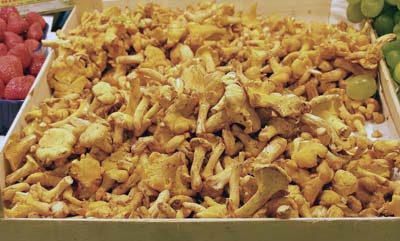
A name for grey chanterelles. Fluted, trumpet-shaped, wild mushrooms with a ruffled edge, dark grey to black in colour. They are commonly found under pine, beech or birch trees from July until the first frosts and thrive in wet summers. They are usually sautéed in butter with chopped onions, but are not considered as tasty as the horn of plenty, which they resemble.
False morel mushrooms. They are deadly poisonous if not cooked, closely resembling real morel mushrooms, being wrinkled and brown in the same way. However, morel mushrooms are symmetrical while false morels are irregular in shape and look like a brown brain, while true morels are more like a sponge. True morels have hollow stems while those of false morels are solid. Be careful to check each of these features before attempting to eat one. They have a fine flavour and are generally parboiled. They are popular in Nordic countries and in Finland especially.
A strange name for the false morel mushroom. They are deadly poisonous if not cooked, closely resembling real morel mushrooms, being wrinkled and brown in the same way. However, morel mushrooms are symmetrical while false morels are irregular in shape and look like a brown brain, while true morels are more like a sponge. True morels have hollow stems while those of false morels are solid. Be careful to check each of these features before attempting to eat one. They have a fine flavour and are generally parboiled. They are popular in Nordic countries and in Finland especially.
Minced (US: ground) or chopped, usually used of meat, specifically beef, and used to top vegetables such as stuffed tomatoes or in hachis parmentier.
A classic dish of French country cooking, this consists of a layer of mashed potato at the bottom of a casserole, with a layer of minced (US: ground) beef (usually left overs) and sauce lyonnaise and then another layer of mashed potato. It may be topped with Gruyère and then gratinated. It is a sort of fancy French version of cottage pie.